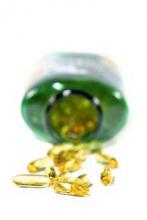NEW ORLEANS – When the Institute of Medicine released updated recommendations on calcium and vitamin D intake in late 2010, the report became the backbone for clinical guidance. But since then, they have been hotly debated among those who say that the recommendations were too weak, and others who say that it has been inappropriately used to herald vitamin D as the next wonder substance, with little scientific evidence backing that claim.
The IOM guidelines "fail the smell test," said Dr. Neil Binkley, a geriatrician and research scientist at the University of Wisconsin–Madison. The recommended intake for a 1-year-old (600 IU/day) is the same as for a 70-year-old. That would make the recommended dietary allowance for vitamin D one of the few RDAs that do not adjust for age, he said at the annual meeting of the American College of Physicians.
In addition, the recommendations were formulated from a public health standpoint. That makes them less useful for determining the best recommended dietary allowance for an individual patient. Knowing an individual’s particular risk factors and variables in his or her life are crucial for determining an appropriate intake, he said.
Vitamin D deficiency is likely a growing issue, not just in the United States, but worldwide. Vitamin D is not commonly found in food, but is easily synthesized from sunlight. Centuries ago, humans wore less clothing and did not wear sunscreen. Now, of course, avoidance of sun exposure is common practice and has likely contributed to lower serum vitamin D levels in modern humans, he said.
For instance, a recent study showed that two traditional sub-Saharan tribes – the Maasai and the Hadzabe – who wear little clothing, do not use sunscreen, and have darkly pigmented skin (putting them at greater risk for vitamin D deficiency) – had a mean serum 25-hydroxyvitamin D concentration of 46 ng/mL (or 115 nmol/L), according to a study (Br. J. Nutr. 2012 Jan. 23 [doi:10.1017/S0007114511007161]).
This serum concentration is much greater than the IOM’s target of "sufficient" levels (defined as greater than 30 nmol/L). Levels between 20 and 30 nmol/L are considered insufficient, and less than 12 is considered deficient. According to these IOM figures, some 80% of whites have sufficient levels, whereas 71% of African Americans and 46% of Mexican Americans have low levels of serum vitamin D. Dr. Binkley said that he considers the IOM cut-offs to be conservative, but even according to those numbers, as much as a third of the U.S. population may be deficient.
Guidelines subsequently issued by the Endocrine Society called for higher RDAs than that recommended by the IOM, underscoring the lack of consensus around what constitutes a sufficient vitamin D intake, said Dr. Binkley.
There’s also lack of consensus around who should be screened for serum vitamin D levels. The Endocrine Society has called for screening of those "at risk," but then categorizes so many people as being at risk that it’s essentially equivalent to total population screening, said Dr. Binkley. He supports screening, in particular of older adults with a history of falls, and of others with a history of nontraumatic fractures. But he does not advocate total population screening.
What should physicians do? First, recognize that not all patients are the same and that a serum concentration of 20 ng/L may not be sufficient for every individual. Also, just urging sun exposure may not be enough for some patients, either. Multiple studies in the literature have shown that serum concentrations can vary widely among individuals, even when they have had equivalent levels of sun exposure, said Dr. Binkley.
Lab tests for serum vitamin D levels have improved over the years, but they are far from perfect.
So what are adequate levels? According to several studies in sun-exposed individuals, 20 ng/mL seems low and levels in the mid-30s seem reasonable, said Dr. Binkley. "I think we need to be above 30," he said, noting that, for many patients, that means a daily intake of 1,000-2,000 IU of vitamin D daily.
That advice jibes with a statement the American Association of Clinical Endocrinologists issued shortly after the IOM report. AACE recommended that an optimal range for most patients should be 30-50 ng/mL. To achieve that, it would be necessary to take 1,000-2,000 IU of vitamin D daily. The group also said that physicians should use the IOM recommendations "in conjunction with clinical judgment to determine the proper vitamin D requirement for any given patient."



